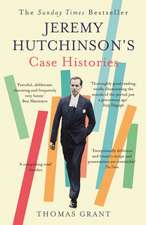Murder: Crime and Society Series
Autor Shani D'Cruze, Sandra Walklate, Samantha Peggen Limba Engleză Paperback – apr 2006
The book also embraces questions of race and gender, in particular cultural constructions of masculinity and femininity on the one hand, and the social processes of 'forgetting and remembering' in the context of particular crimes on the other. Particular murders analysed included those of Myra Hindley, Harold Shipman and the Bulger murder.
Preț: 258.09 lei
Preț vechi: 310.43 lei
-17% Nou
Puncte Express: 387
Preț estimativ în valută:
49.42€ • 50.98$ • 40.96£
49.42€ • 50.98$ • 40.96£
Carte tipărită la comandă
Livrare economică 20 februarie-06 martie
Preluare comenzi: 021 569.72.76
Specificații
ISBN-13: 9781843921691
ISBN-10: 1843921693
Pagini: 188
Dimensiuni: 156 x 234 x 13 mm
Greutate: 0.36 kg
Ediția:1
Editura: Taylor & Francis
Colecția Willan
Seria Crime and Society Series
Locul publicării:Oxford, United Kingdom
ISBN-10: 1843921693
Pagini: 188
Dimensiuni: 156 x 234 x 13 mm
Greutate: 0.36 kg
Ediția:1
Editura: Taylor & Francis
Colecția Willan
Seria Crime and Society Series
Locul publicării:Oxford, United Kingdom
Cuprins
1. Cataloguing murder 2. Devils and demons: the social construction of murder and murderers 3. Murderous women 4. Murderous children 5. Murderous men: intimate and domestic killings 6. Murderous men: killing acquaintances and strangers 7. Conclusion: rendering them pathological
Notă biografică
Shani D'Cruze was formerly a Lecturer in Criminology at Manchester Metropolitan University. She is an Honorary Fellow at Keele University, and Emeritus Member of the SOLON Board at Plymouth University in light of her role as Director of the Feminist Crime Research Network.
Sandra Walklate is the Eleanor Rathbone Chair of Sociology at Liverpool University.
Samantha Pegg is a Lecturer in the Law School at Nottingham Trent University.
Sandra Walklate is the Eleanor Rathbone Chair of Sociology at Liverpool University.
Samantha Pegg is a Lecturer in the Law School at Nottingham Trent University.
Recenzii
Murder examines the socio-cultural construction of murder, specifically the interpersonal murder of intimates and acquaintances, and the manners by which these constructions have changed throughout historical and contemporary contexts. The authors focus on constructions and utilize a case study approach in an effort to understand why murderers are considered to be categorically different from the rest of society. The case study method also allows one to examine how the development of a narrative story affects dimensions that are both related to and unrelated to the crime itself; how law enforcement officials construct the crime, how the prosecution and defense construct their own interpretation of the crime given the evidence, how the media determines newsworthiness and presents their own perspective of the crime, and how the public reacts to the various constructions to develop their own understanding of the crime. Murder consists of three overarching themes. Chapters one and two discuss some of the theoretical and empirical issues surrounding the study of murder. Social, cultural, and legal definitions of murder are considered and are followed by an underlying advocacy for qualitative research given the problems of existing data and the need to provide a more contextual understanding of murder. Subsequent discussion examines the social construction of murder and murderers and how such constructions are associated with notions of evil. Chapters three through six address the murder of intimates and acquaintances through an examination of perpetrators and victims. The focus is placed upon women who murder male or female intimates or acquaintances, children who murder children, men who murder intimate or domestic female partners, and men who murder their male friends or acquaintances. Each perpetrator and victim typology begins with a conceptual and theoretical overview of the existing literature and supplements the review with a case study. Chapter seven brings the discussion full-circle. Interpersonal themes that underlie murders, murderers, and victims may have some similarities and differences, but the single theme that links them all together is the continual attempt to label the offender as a social anomaly. Importantly, the authors argue that such a broad generalization must be contextualized. To develop a genuine understanding of intimate or acquaintance murder, one must consider the prevalent socio-cultural, historical, and structural mechanisms that exist within society. The strength of this book is its ability to move beyond the convention of presenting quantitative aggregates and analyses of trends that are followed by discussions of historical and contemporary theories to explain behavior. Socio-cultural constructions arguably underlie all social phenomenon and it is important to recognize and critically assess their effect on how one views the world. In terms of weaknesses, many of the major points to be taken from the book were redundantly discussed in every chapter, which may be frustrating to some readers. Additionally, the attempt to develop a gendered understanding of murder walks a fine line between actually developing the understanding and simply offering a reductionist position. That is, the explanatory focus on themes of masculinity and femininity offered in discussions of offender and victim typologies seems to suggest that gender determines behavioral tendencies. Careful reading will note, however, that gender is one dynamic in a multitude of considerations that must be made to truly understand the murder of intimates and acquaintances. Murder is an excellent follow-up to an introductory text on murder or homicide. Students, academics, or practitioners interested in the topics of murder, social constructions of violence, contextual analyses, and those interested in the relationship between criminal justice and the media will find the text particularly relevant. ERIC L. GROMMON Michigan State University
Descriere
This book uses detailed case studies as a way of exemplifying and exploring more general questions of socio-cultural responses to murder and their explanation, and also incorporates a valuable historical perspective to this issue. It is a seeks accessible account of the subject for people coming to it for the first time.



















